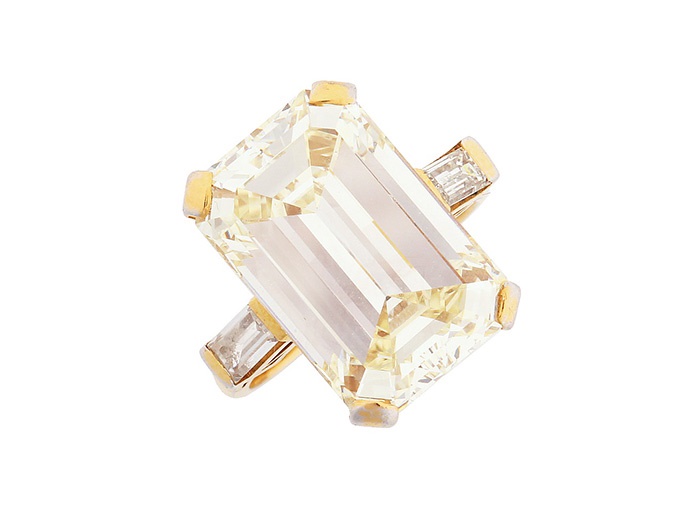The History of Kutchinsky Jewellery
Amongst the most celebrated names in British jewellery history, is Kutchinsky.
11/03/2024
Amongst the most celebrated names in British jewellery history, is Kutchinsky. Their vintage pieces remain highly sought after by collectors and enthusiasts who take much delight in these extravagant and theatrical jewels. To understand the craftmanship and design of a celebrated jeweller, one must first understand their background, as this will undoubtedly have influenced their creative design.
 A rare 11.03ct diamond three-stone Kutchinsky ring
A rare 11.03ct diamond three-stone Kutchinsky ring
Hirsch Kutchinsky (Harris) emigrated from Poland with his family in 1893, arriving in the UK where he promptly set up a jewellery workshop with his son, Moshe-Aron Kutchinsky (Morris), in Cannon Street Road, East End London. While their establishment may have been new, they had decades of experience and had served as jewellers to the Court of Ludwig of Bavaria. They quickly built up a reputation for producing unique and quality pieces, initially focusing on platinum and diamonds which was in favour during the Edwardian era. In 1914 the workshop was moved to Commercial Road, that same year Morris’ youngest son Joseph was born.
 A Kutchinsky platinum and 18ct yellow gold diamond bracelet
A Kutchinsky platinum and 18ct yellow gold diamond bracelet
Joseph - “Jo”, left school in 1928 to join the family business, proving to be a very skilled diamond polisher, as well as a natural salesman. He would work his way through the company learning the importance of fine craftsmanship and the value of impeccable customer service. Rather aptly, Joseph married Lily Diamond, in 1940 before joining the war effort. He would become a father in 1945 with the birth of his first son Roger, and again in 1950 when his second son Paul arrived.
When World War II finally ended, Joseph would return to the family business with his enduring vigour and renewed optimism. He was well-liked by his customers and employees, a charming and respected man, he would be responsible for overseeing the production of Kutchinsky’s most iconic and coveted jewellery. The pieces produced during the 1940s and 50s were intentionally bold and ostentatious, a deliberate celebration of the end of wartime. Diamonds appeared in various cuts of round, marquise and baguette, coloured gemstones were used to highlight details and coral, turquoise and tigers eye complimented the contrast. In 1958 Joseph moved the business again, to a more suiting location on Brompton Road in Knightsbridge.
Kutchinsky – a diamond and ruby bracelet in 18ct gold
Styles in the 1960s and 70s became more textured and naturalistic, with Kutchinsky positioning itself alongside the likes of Grima and Chaumet. They became well known for their playful menagerie of animal jewels, from the whimsical to the kitsch, each piece was executed with masterful construction solidifying their reputation. The business continued to thrive, not just in London, but throughout the world and particularly in the newly prosperous Middle East.
In 1989 Lily, Josephs wife, fell seriously ill. Roger and Paul had both joined the family business by this stage, Joseph took a less active role in the day-to-day management of Kutchinsky and devoted himself to caring for the love of his life. Sadly, she passed away three years later.
Unfortunately, the collateral damage continued, Paul had become obsessed with creating the world’s largest jewelled egg, one to rival Fabergé’s. The masterpiece would become known as the Argyle Library Egg, 60cm tall it required more than 15kg of 18ct gold, 24,000 pink diamonds from the Argyle mine in Australia, and 7,000 hours of painstaking labour by talented goldsmiths, the project stretched financials to breaking point. On completion in 1990, the egg was valued at £7 million. However, the invasion of Kuwait and the ensuing Gulf War made it impossible for Paul to find a suitable buyer, forcing Kutchinsky into financial hardship, and the business having to be sold to Moussaieff Jewellers Ltd in 1991. Thereafter, the egg was ultimately sold on to a private buyer. Joseph retired upon completion of the business take-over, and his final years were probably his most unhappy, as he had lost his lifelong companion and his business, whilst the untimely passing of his son Paul in March 2000 no doubt created further anguish. Joseph Kutchinsky passed away peacefully on 26th October 2000 aged 86.
read more
How Do I know if My Jewellery is Valuable?
How Can You Tell if Jewellery is Vintage?
Are Jewellery Valuations Free?

Nicky Houston
Our Head of Jewellery, Watches & Silver... Nicky is a highly respected Auctioneer & Valuer, who had dreams of becoming an artist. Whilst she may not have made it as a successful artist herself, Nicky has helped many a customer to successfully sell and buy beautiful pieces of jewellery and works of art over her many years working within the auction industry.
Jewellery Silver & Objects of Virtue Watches
Do you have any Kutchinsky jewellery that you are considering selling?
With a global audience of over 10 million, Dawsons can achieve the best price for you at auction.
Get in touch with an expert jewellery valuer today for sales advice. We would be delighted to help: